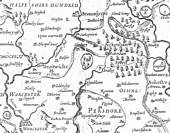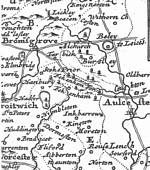|
|||
|
William Webb, son of William, was christened at Whitchurch in Hampshire in 1737. The parish records show several Webbs in the area at this time, quite a few of them papermakers, and William was also destined for this trade. He would have been required to serve an apprenticeship and it is possible that William was apprenticed to Henri de Portal at Bere Mill (Ref 1), as his extended family was connected with the Bere paper mills around Whitchurch and Laverstoke. It is however also possible that William served his apprenticeship at a paper mill in Sawston, Cambridgeshire. We know he travelled to Cambridgeshire, for it was in that county, in the town of Stapleford in May 1764, that he married Martha (who may have been a distant relative as intriguingly, her surname was also Webb! ) (Ref 2). Their first son, William, was christened in the nearby town of Sawston the following year.
Travelling to Cambridgeshire was not the only journey that William made in his lifetime; it seems he moved around the country to a surprising extent considering the difficulties of travelling on poor roads in the eighteenth century. There were two papermills in the Sawston area at this time. The Danford (or Dernford) Mill was manufacturing paper from the mid 17th century, specialising in high quality writing paper. However, by 1796 it had ceased to make paper but continued as a corn mill. The Borough Mill had been used as a flour mill but, from about 1753, manufactured paper under the supervision of William Fairchild (Ref 3) and his business partner Joseph Keir (who died penniless in 1761). It
is uncertain at which of these Sawston mills William was employed,
but he and Martha moved from Cambridgeshire, perhaps because
the mills were failing. They apparently settled in Eynsham,
Oxfordshire, where their second son, Edward, was christened
in 1768. Eynsham had for many years been associated with papermaking.
In 1682 a London dyer named George Hagar was a tenant at one
of the ancient mills, which he used for papermaking having obtained
a patent for the production of white paper for books. He later
supplied paper for Bibles printed in Oxford. In 1756 his mill
was burned down, but rebuilt. In 1785 the mill was run by Stephen
Faichen, and later by the Swann family, who were supplying paper
to the Clarendon Press in Oxford by 1850. We don't know why William decided to move to yet another part of the country, or indeed how he came to know of a job being available at Beoley paper mill (near Redditch, in Worcestershire), though subsequent correspondence shows there to have been a significant amount of communication between associated trades, despite the difficulties of delivering mail by coach using poorly maintained roads. William may have read an advertisement for mill workers similar to the one found in The Berrows Journal (Ref 4) of July 18th 1768: "WANTED, by John Holyoak, at Hewell papermill, near Bromsgrove Worcestershire, Three or four JOURNEYMEN PAPERMAKERS, for writing work. Those that are good workmen will meet with the greatest encouragement, and no other need apply. Those that intend to work as above are desired to make their application in a week from the date hereof." (See also Ref 5). Whatever the reason, 30 year-old William Webb, with his wife Martha and their young family, set out from Eynsham around 1770 (certainly before 1773) to start a new life in Worcestershire. Beoley is an ancient village conveniently located on the old Roman road of Icknield (or Rykneild) Street, just over two miles northeast of present-day Redditch (Ref 6). There were apparently two papermills at Beoley in 1650, but it is not clear whether they both survived until the 18th century. William worked at one of the Beoley papermills and his sons subsequently worked in the same trade at other mills in the area. There were already several Webb families in Worcestershire at this time, but no link has been found between them and William's family. Having settled in Beoley, William and Martha added to their family. Their third son, James, was christened at Beoley in 1773, followed by daughter Martha in 1775. They had another son Joseph, who must also have been born around 1775, although a record of his christening has yet to be found. (Ref 7). Their youngest son Charles was christened in 1778 at the neighbouring old chapel of St Stephen, which at this time was the only remaining structure of the once substantial Cistercian abbey and monastery of Bordesley (Ref 8) ,founded in 1138. After the Dissolution of the monasteries by Henry VIII (from 1538) the lay brothers who had worked at the monastery moved to higher ground and established the hamlet of Redditch around the area we now know as Church Green. Redditch is the main setting for the Webb family story related on this web site, but when William arrived at Beoley, Redditch was yet to rise to prominence (Ref 9). The hamlet would have been well known to William and Martha but it is not found on Speede's map of 1610, nor on Saxton's map of 1637; it is however on Morden's map of 1695, and Nash's map of 1781. Speede's map 1610 ...........Morden's map 1695.......Nash's map 1781 For a sketch of what Redditch was like in 1776, click here for Norman Neasom's interpretation of Joseph Monk's account. At the turn of the 19th century William Webb worked at Beoley papermill and was a valued employee. There was another mill (from 1645) in the area at Hewell, marked on Beighton's map of Warwickshire in 1725. Its owner in 1785 was James Holyoak, and he took on William's son Joseph as an apprentice papermaker. Joseph's story is detailed in Chapter 3. Beoley mill may be the one referred to on Beighton's map of Warwickshire (1725) as belonging to Nicholas Clows. The mill was then acquired by Henry Mander and it was William Webb who acted as witness to Mander's will in 1782. After Henry Mander's death, the mill was subsequently managed by Henry's widow, Sarah, and William evidently advised her about certain business matters. When the mill was mortgaged to John and Matthew Mills, William Webb was their right-hand-man, as portrayed in their business letters (Ref 10) which are held at Warwick Record Office. From these letters we learn that William was a respected and no doubt talented papermaker, with a lifetime of experience in the trade. He died and was buried at Beoley in 1810. Beoley papermill changed hands again in 1826 and some details of its subsequent history are detailed here (Ref 11). I am indebted to Valerie Goodbury for some of the information on Beoley Papermill, found in her article in The Quarterly (33) January 2000. The death of William may not have been the final link between the Webb family and Beoley papermill. At least two of his sons followed in the trade of papermaking, and although there is no documentary evidence to connect them to this particular mill, it is reasonable to assume that they did work there, at least for a while. |
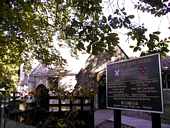
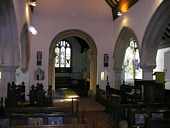
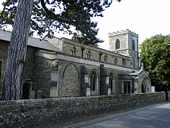 Sawston
Church
Sawston
Church